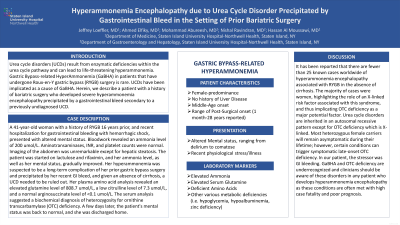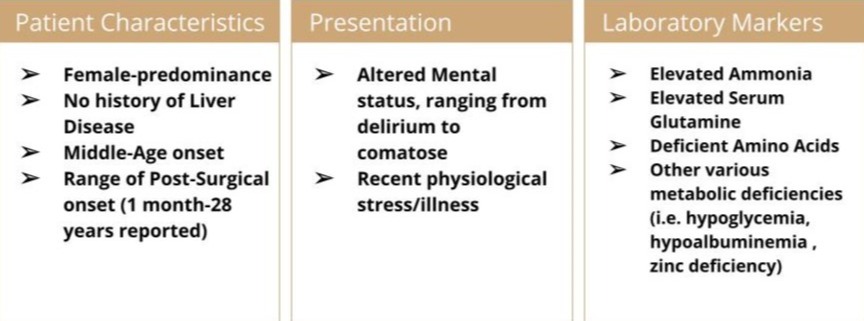Monday Poster Session
Category: Liver
P2535 - Hyperammonemia Encephalopathy Due to Urea Cycle Disorder Precipitated by Gastrointestinal Bleed in the Setting of Prior Bariatric Surgery
Monday, October 23, 2023
10:30 AM - 4:15 PM PT
Location: Exhibit Hall

Has Audio
- JL
Jeffrey Loeffler, MD
Staten Island University Hospital Northwell Health
Staten Island, New York
Presenting Author(s)
Jeffrey Loeffler, MD, Ahmed Elfiky, MD, Mohammad Abureesh, MD, Hassan Al Moussawi, MD, Nishal Ravindran, MD
Staten Island University Hospital Northwell Health, Staten Island, NY
Introduction: Urea cycle disorders (UCDs) result from enzymatic deficiencies within the urea cycle pathway and can lead to life-threatening hyperammonemia. Gastric Bypass-related HyperAmmonemia (GaBHA) in patients that have undergone Roux-en-Y gastric bypass (RYGB) surgery is rare. UCDs have been implicated as a cause of GaBHA. Herein, we describe a patient with a history of bariatric surgery who developed severe hyperammonemia encephalopathy precipitated by a gastrointestinal bleed secondary to a previously undiagnosed UCD.
Case Description/Methods: A 41-year-old woman with a history of RYGB 16 years prior, and recent hospitalization for gastrointestinal bleeding with hemorrhagic shock, presented with altered mental status. Bloodwork revealed an ammonia level of 200 umol/L. Aminotransaminases, INR, and platelet counts were normal. Imaging of the abdomen was unremarkable except for hepatic steatosis. The patient was started on lactulose and rifaximin, and her ammonia level, as well as her mental status, gradually improved. Her hyperammonemia was suspected to be a long-term complication of her prior gastric bypass surgery and precipitated by her recent GI bleed, and given an absence of cirrhosis, a UCD needed to be ruled out. Her plasma amino acid analysis revealed an elevated glutamine level of 808.7 umol/L, a low citrulline level of 7.3 umol/L, and a normal arginosuccinate level of < 0.1 umol/L. The serum analysis suggested a biochemical diagnosis of heterozygosity for ornithine transcarbamylase (OTC) deficiency. A few days later, the patient's mental status was back to normal, and she was discharged home.
Discussion: It has been reported that there are fewer than 25 known cases worldwide of hyperammonemic encephalopathy associated with RYGB in the absence of cirrhosis. The majority of cases were women, highlighting the role of an X-linked risk factor associated with this syndrome, and thus implicating OTC deficiency as a major potential factor. Urea cycle disorders are inherited in an autosomal recessive pattern except for OTC deficiency which is X-linked. Most heterozygous female carriers will remain asymptomatic during their lifetime; however, certain conditions can trigger symptomatic late-onset OTC deficiency. In our patient, the stressor was GI bleeding. GaBHA and OTC deficiency are underrecognized and clinicians should be aware of these disorders in any patient who develops hyperammonemic encephalopathy as these conditions are often met with high case fatality and poor prognosis.

Disclosures:
Jeffrey Loeffler, MD, Ahmed Elfiky, MD, Mohammad Abureesh, MD, Hassan Al Moussawi, MD, Nishal Ravindran, MD. P2535 - Hyperammonemia Encephalopathy Due to Urea Cycle Disorder Precipitated by Gastrointestinal Bleed in the Setting of Prior Bariatric Surgery, ACG 2023 Annual Scientific Meeting Abstracts. Vancouver, BC, Canada: American College of Gastroenterology.
Staten Island University Hospital Northwell Health, Staten Island, NY
Introduction: Urea cycle disorders (UCDs) result from enzymatic deficiencies within the urea cycle pathway and can lead to life-threatening hyperammonemia. Gastric Bypass-related HyperAmmonemia (GaBHA) in patients that have undergone Roux-en-Y gastric bypass (RYGB) surgery is rare. UCDs have been implicated as a cause of GaBHA. Herein, we describe a patient with a history of bariatric surgery who developed severe hyperammonemia encephalopathy precipitated by a gastrointestinal bleed secondary to a previously undiagnosed UCD.
Case Description/Methods: A 41-year-old woman with a history of RYGB 16 years prior, and recent hospitalization for gastrointestinal bleeding with hemorrhagic shock, presented with altered mental status. Bloodwork revealed an ammonia level of 200 umol/L. Aminotransaminases, INR, and platelet counts were normal. Imaging of the abdomen was unremarkable except for hepatic steatosis. The patient was started on lactulose and rifaximin, and her ammonia level, as well as her mental status, gradually improved. Her hyperammonemia was suspected to be a long-term complication of her prior gastric bypass surgery and precipitated by her recent GI bleed, and given an absence of cirrhosis, a UCD needed to be ruled out. Her plasma amino acid analysis revealed an elevated glutamine level of 808.7 umol/L, a low citrulline level of 7.3 umol/L, and a normal arginosuccinate level of < 0.1 umol/L. The serum analysis suggested a biochemical diagnosis of heterozygosity for ornithine transcarbamylase (OTC) deficiency. A few days later, the patient's mental status was back to normal, and she was discharged home.
Discussion: It has been reported that there are fewer than 25 known cases worldwide of hyperammonemic encephalopathy associated with RYGB in the absence of cirrhosis. The majority of cases were women, highlighting the role of an X-linked risk factor associated with this syndrome, and thus implicating OTC deficiency as a major potential factor. Urea cycle disorders are inherited in an autosomal recessive pattern except for OTC deficiency which is X-linked. Most heterozygous female carriers will remain asymptomatic during their lifetime; however, certain conditions can trigger symptomatic late-onset OTC deficiency. In our patient, the stressor was GI bleeding. GaBHA and OTC deficiency are underrecognized and clinicians should be aware of these disorders in any patient who develops hyperammonemic encephalopathy as these conditions are often met with high case fatality and poor prognosis.

Figure: Gastric Bypass-related HyperAmmonemia
Disclosures:
Jeffrey Loeffler indicated no relevant financial relationships.
Ahmed Elfiky indicated no relevant financial relationships.
Mohammad Abureesh indicated no relevant financial relationships.
Hassan Al Moussawi indicated no relevant financial relationships.
Nishal Ravindran indicated no relevant financial relationships.
Jeffrey Loeffler, MD, Ahmed Elfiky, MD, Mohammad Abureesh, MD, Hassan Al Moussawi, MD, Nishal Ravindran, MD. P2535 - Hyperammonemia Encephalopathy Due to Urea Cycle Disorder Precipitated by Gastrointestinal Bleed in the Setting of Prior Bariatric Surgery, ACG 2023 Annual Scientific Meeting Abstracts. Vancouver, BC, Canada: American College of Gastroenterology.
